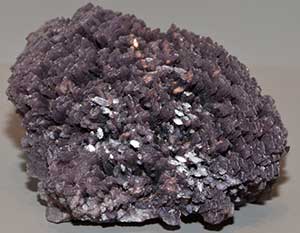 |
| Spodumene - LiAlSi2O6. |
 |
| Lepidolite - K(Li,Al)3(Si,Al)4O10(F,OH)2. |
 |
| Petalite - LiAlSi4O10. |
Lithium is a metallic element that is widely distributed in the earth's crust at low concentrations. Lepidolite, petalite, and spodumene, are important mineral sources of lithium. Subsurface brines, which is water that is saltier than seawater) are the dominant raw material for lithium carbonate production worldwide because of lower production costs as compared with the costs for hard rock ores. In the United States, lithium brines are produced and processed in Nevada, and imported material is processed in North Carolina. Chile, China, Australia, and Russia are major lithium producers. The United States is the leading consumer of lithium minerals and compounds and the leading producer of value-added lithium materials. The use of lithium compounds in ceramics, glass, and primary aluminum production represented more than 60% of estimated consumption. Other major end uses for lithium were in the manufacture of lubricants and greases, pharmaceuticals, and synthetic rubber.
Background
Lithium, the lightest metal, is in a group of elements called alkali metals or Group I elements, it has the atomic number of 3. This group includes lithium (Li), potassium (K), and sodium (Na). The three alkali metals are highly reactive with oxygen and water, so they are stored in oil. Although lithium will react dramatically when put in water, it is the least reactive alkali metal. When it reacts with water it bounces on the top of the water because it is lighter than water.
The metal lithium is a silvery-white; petalite is found in the minerals spodumene, lepidolite mica, and amblygonite.
Johan A. Arfvedson, of Stockholm, Sweden, first discovered lithium in 1817. It was first isolated by W.T. Brande and Humphrey Davy in the 19th century, but it was not commercially produced until 1923.
Name
The name lithium comes from the Greek word lithos which means stone because lithium was first discovered in rocks and other two alkali metals were first discovered in plants. Lithium was first found in the mineral called petalite (LiAl(Si2O5)2, lithium aluminum silicate).
Sources
Some lithium is recovered from the mineral spodumene. Commercial quantities of spodumene are in a special igneous rock deposit that geologists call a pegmatite. In pegmatites, the liquid rock (magma) cools so slowly that crystals have time to grow very large. The largest spodumene crystal ever found was found in a pegmatite in South Dakota.
Most lithium is recovered from brine, or water with a high concentration of lithium carbonate. Brines trapped in the Earth's crust (called subsurface brines) are the major source material for lithium carbonate. These sources are less expensive to mine than from rock such as spodumene, petalite, and other lithium-bearing minerals.
It is estimated that the United States has approximately 760,000 tons of lithium. The resources in the rest of the world are estimated to be 12 million tons. The United States is the world's leading consumer of lithium and lithium compounds. The leading producers and exporters of lithium ore materials are Chile and Argentina. China and Russia have lithium ore resources, but it is presently cheaper for these countries to import this material from Chile than to mine their own.
Uses
More than one-half of the lithium compounds consumed are used in the manufacture of glass, ceramics, and aluminum. Lithium is also used in making synthetic rubber, greases and other lubricants.
Lithium batteries are proving to be an effective and affordable alternative to traditional batteries, and also in new battery applications.
Lithium is mixed with other light metals such as aluminum and magnesium to form strong, light-weight alloys (an alloy is a mixture of metals).
Some lithium, in the form of lithium carbonate or lithium citrate, is used as medicine to treat gout (an inflammation of joints) and to treat serious mental illness.
Substitutes and Alternative Sources
Potassium compounds can be used in glass and ceramic production. Greases can be made using calcium soaps, for example, in place of lithium compounds. In some cases, glass, polymers and resins can be used in place of aluminum-lithium alloys. Zinc, magnesium, nickel and cadmium, and even mercury, can be used to make batteries in place of lithium. (It must be noted that mercury is being phased out of use due to the fact it is so poisonous.)